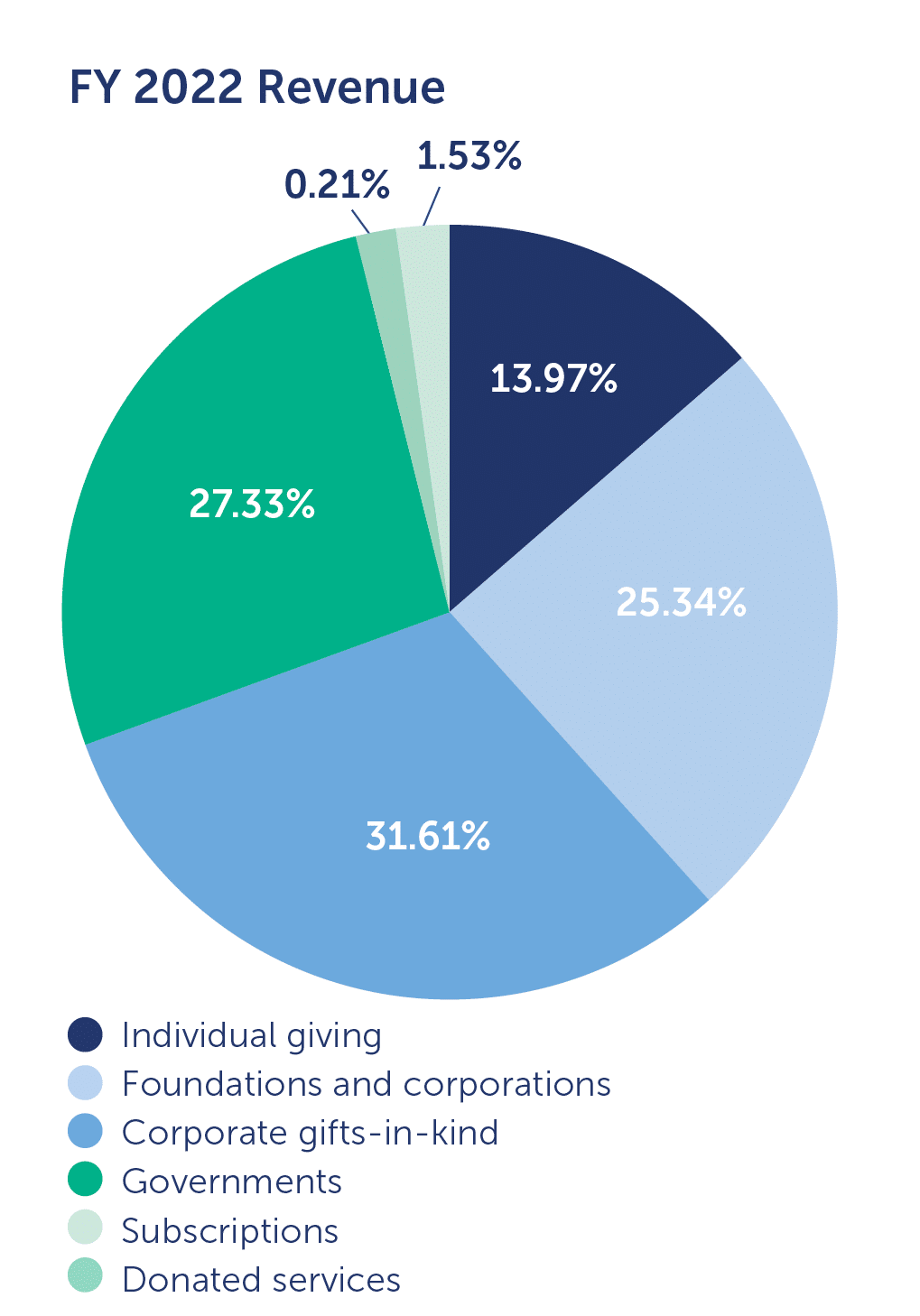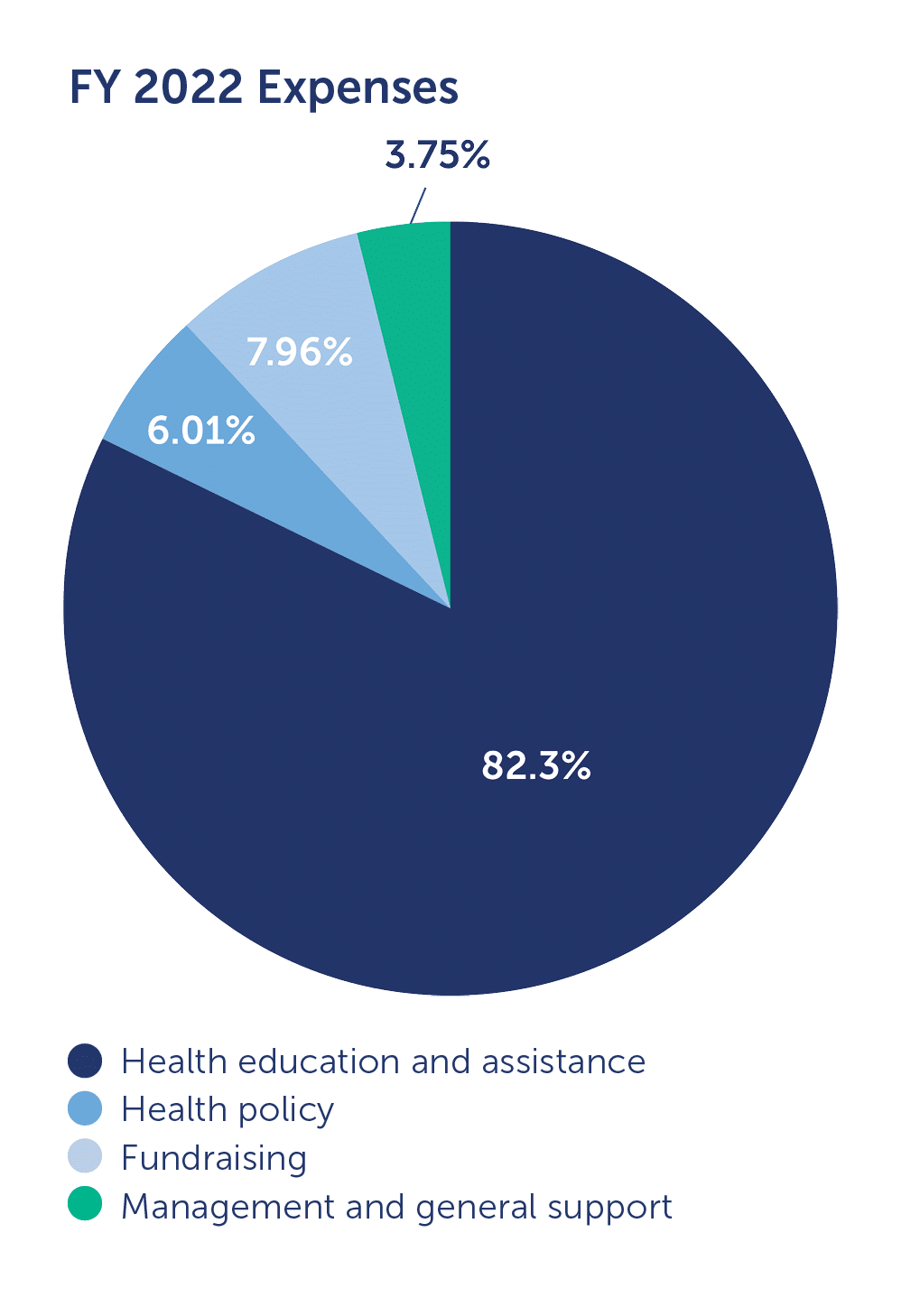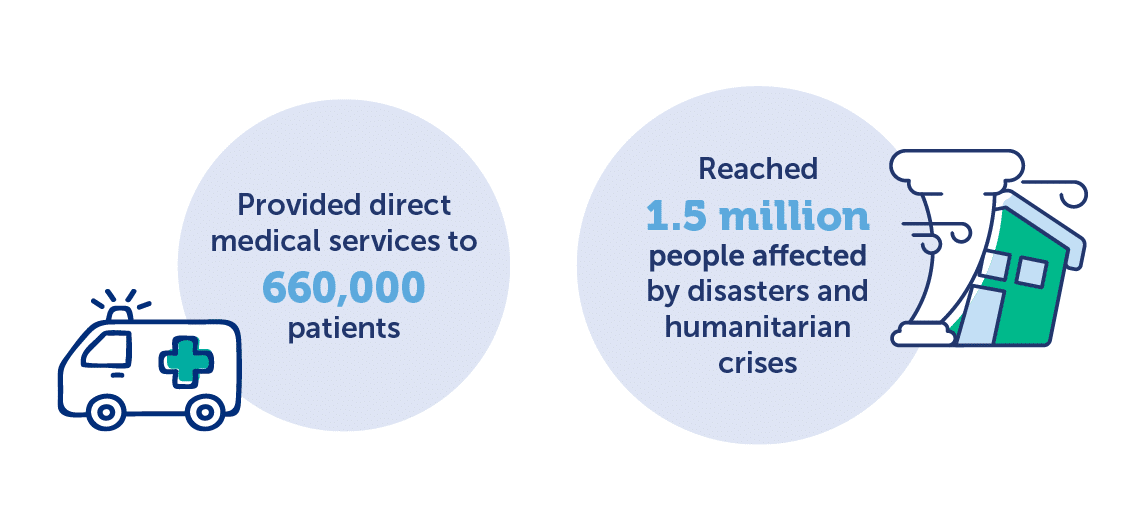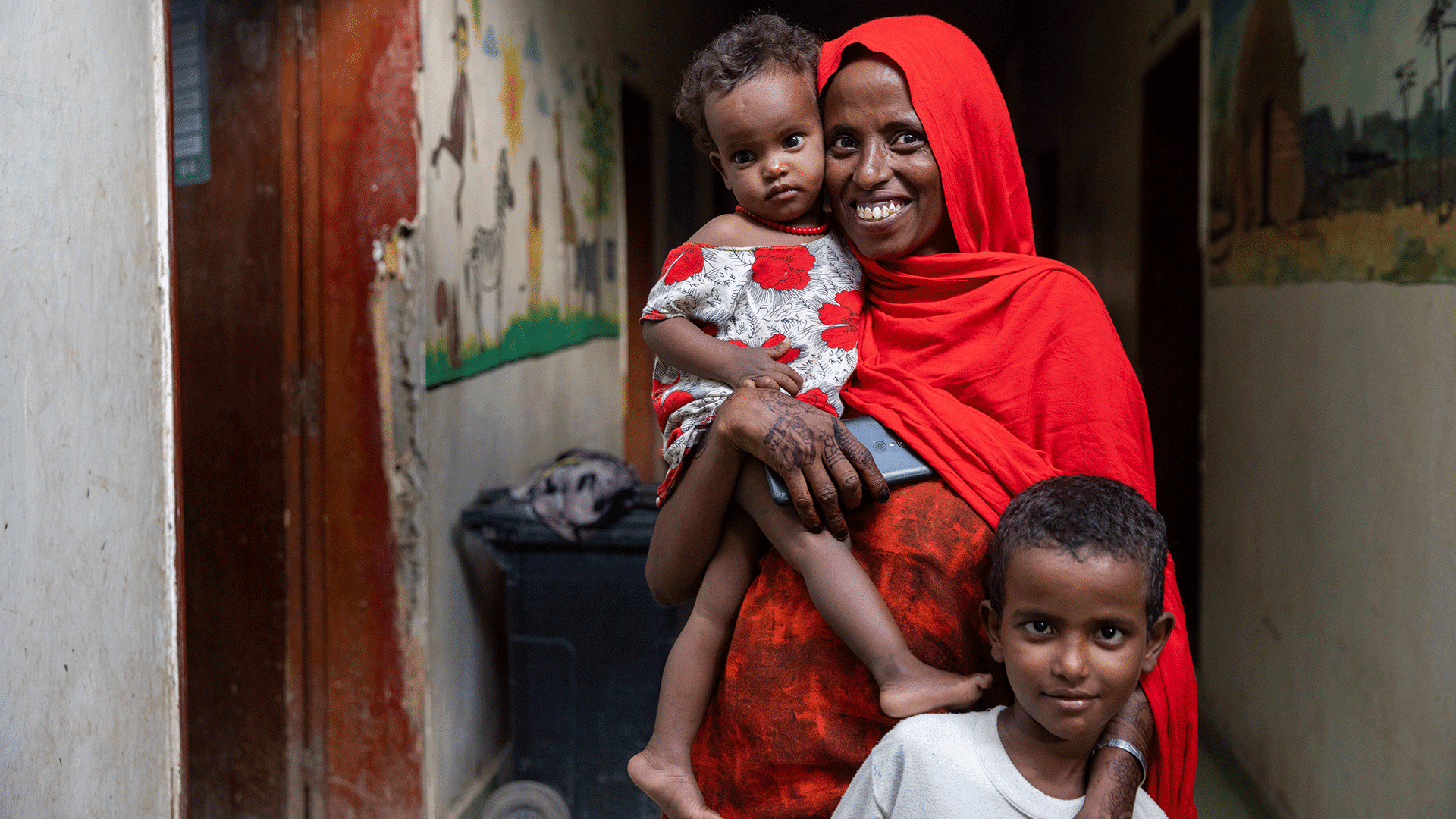
2022 Annual Report
Urgent Relief Lasting Impact
A Year of Transformative Impact
This report provides an overview of Project HOPE’s impact in 2022 and the incredible accomplishments of our teams around the world. In a year marked by conflict, disasters, humanitarian crises, and major health inequities, Project HOPE’s teams worked tirelessly to improve access to health care in some of the communities that needed it most, thanks to the generous support of our partners.
Although this report outlines the far-reaching impact of our work and the millions of lives we were able to touch, there is even more that cannot be captured on paper — like the dedication of our global teams, the courage they show in their work, and their commitment to delivering humanitarian aid to families and strengthening health systems in need. From the front lines of conflict to the quiet community health clinics that don’t make headlines, Project HOPE’s teams are living out the core belief of our entire organization in more than two dozen countries worldwide: that everyone, everywhere deserves access to the health care they need to reach their full potential.
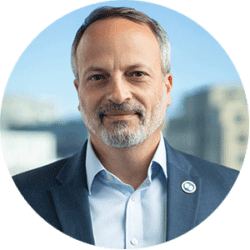
Rabih Torbay
President & CEO
An Organization that Can Meet the World’s Needs
During the last several years, we have spent considerable effort building an organization capable of delivering service excellence to people in need around the world. We have also streamlined our operations, focusing on our programs in the field that transform lives.
It’s fortunate that we have been doing this work, because in 2022 we were faced with profound tragedy in Ukraine. Much of Ukraine’s health care infrastructure has been compromised, which has created significant risks, not just for those with acute illnesses, but also for those with chronic conditions.
Project HOPE stepped in, being one of the first humanitarian assistance organizations on the ground thanks to our long-standing relationship with University Children’s Hospital of Kraków, Poland. We provided generators, insulin, mental health support, and much more to bolster health systems in the nation’s time of need. We believe that we will be working in Ukraine for a long time and are already thinking about the long-term rebuilding that will be needed once the conflict subsides.
Because of the progress we’ve already made in strengthening our overall capabilities, we were able to perform this urgent work while also fully delivering on all of our other program commitments around the world. This was not an insignificant challenge, but it was one to which we successfully rose.
You should be proud of the progress Project HOPE has made and our ability to rise to challenges wherever they occur in the world. Every day, we are helping more people realize better health outcomes. And that’s our ultimate objective.
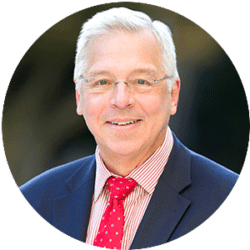
Reynold W. Mooney
Chair, Project HOPE Board of Directors
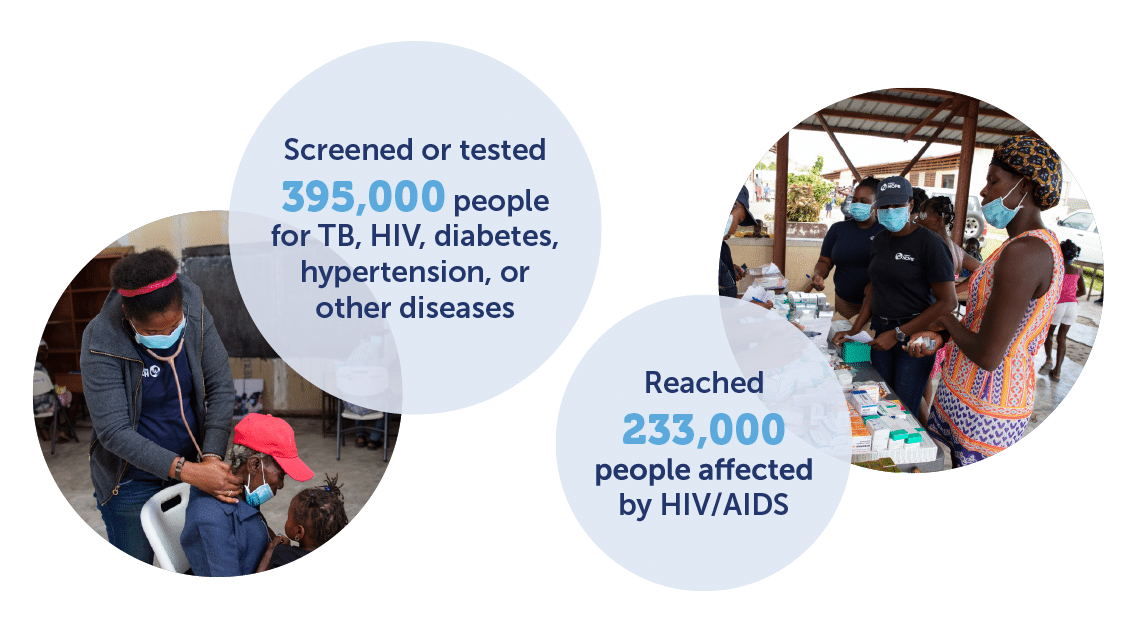
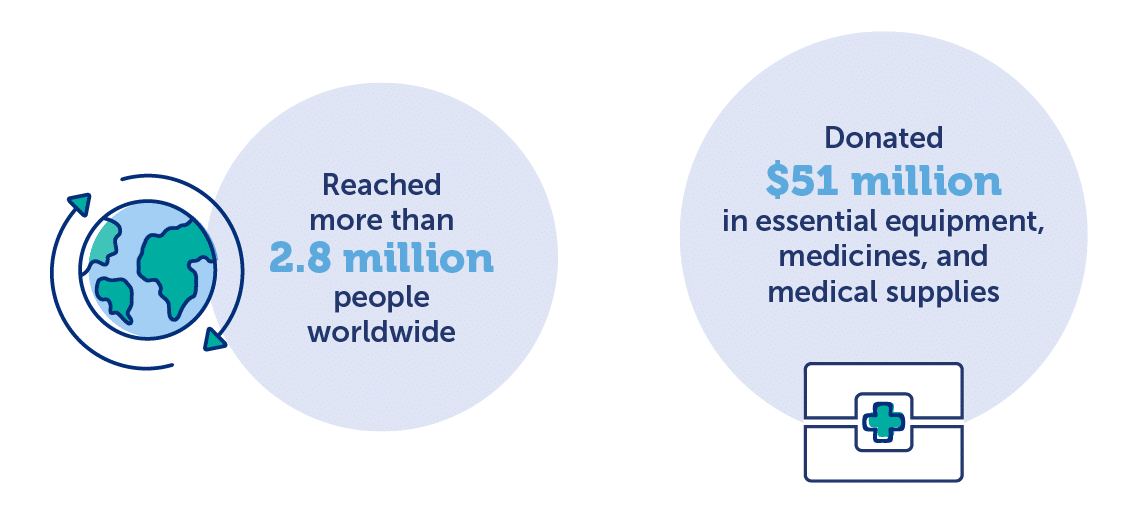

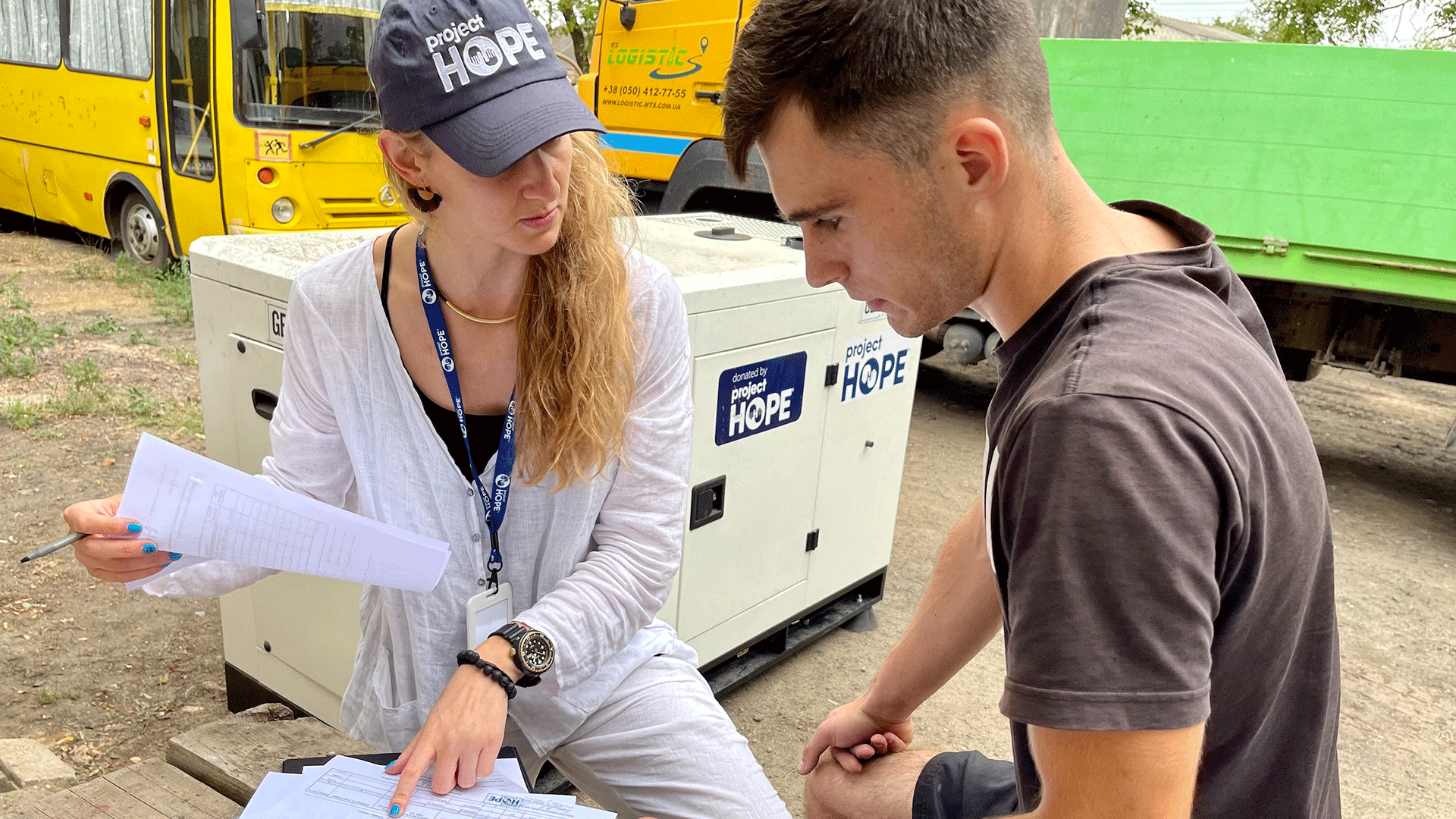
Delivering Urgent Relief to Ukraine
In the early hours of February 24, 2022, Russian forces invaded Ukraine and launched an unprecedented assault by land and air. The devastation was profound and widespread: In a matter of days, more than 1 million refugees fled Ukraine, most of them women and children. It was a number that would eventually grow to become Europe’s largest refugee crisis since World War II.
Project HOPE mobilized a rapid response to the crisis and immediately deployed team members to provide health and humanitarian assistance across Ukraine, Poland, Moldova, and Romania. As air raid sirens rang out across Kyiv, Odesa, and Lviv, our teams rushed medicines and medical supplies to hospitals that suddenly found themselves in desperate need. As women and children crossed international borders, we met them with mobile clinics and mental health support across the region. And as courageous health care workers faced a surge in traumatic injuries, we provided the medicines, equipment, and training they needed when every second mattered.
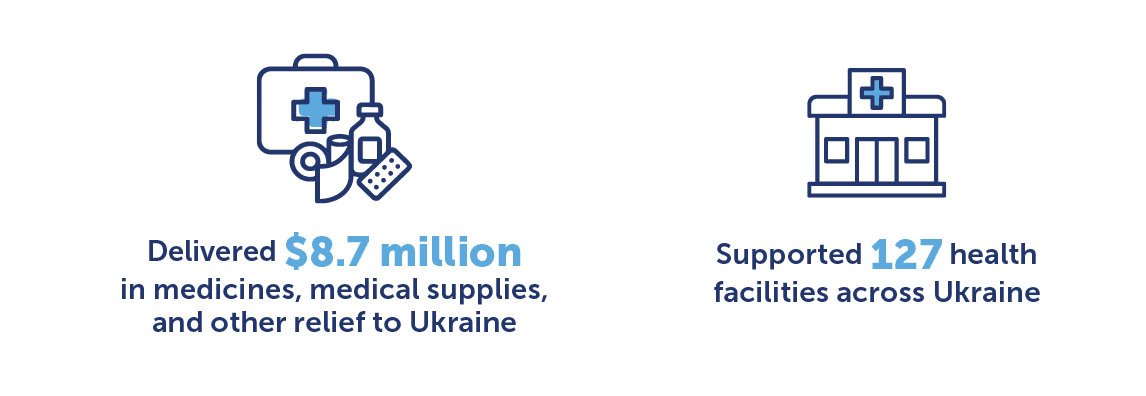
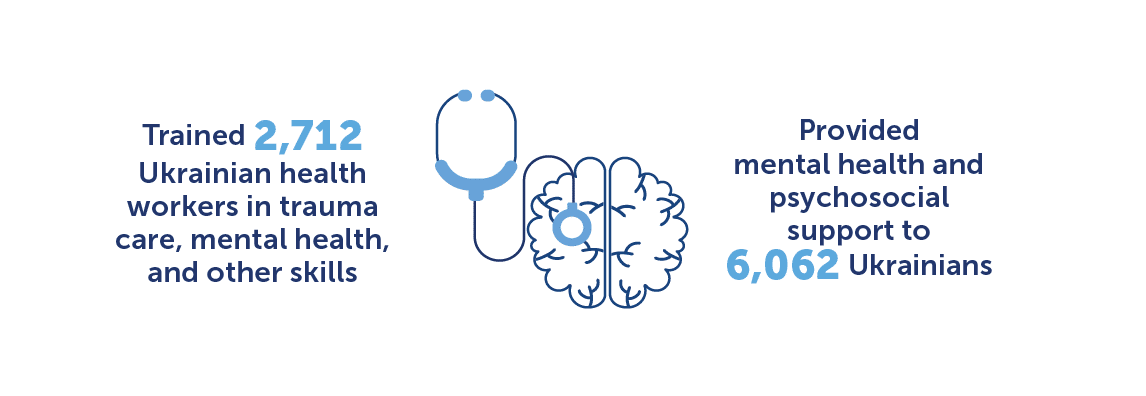
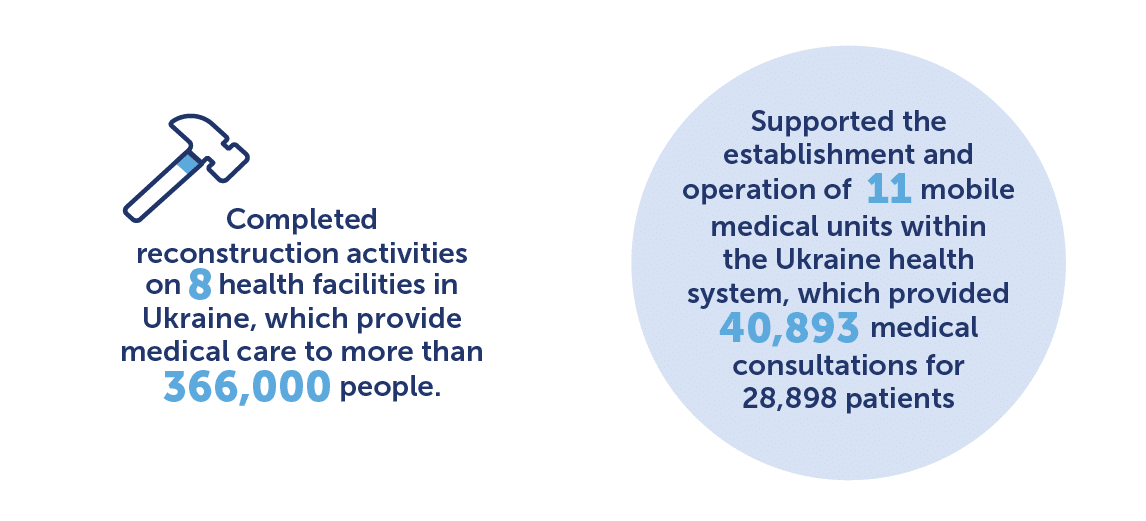
As Russia’s invasion continued, the world watched as the dramatic scale of Ukraine’s humanitarian crisis became clear. Project HOPE’s response grew into a comprehensive, coordinated humanitarian response that stretched across Ukraine and into three neighboring countries. While our teams continued to deliver hundreds of pallets of gravely needed medicines and medical supplies, our work also evolved to meet the growing needs of a health system pushed to its limits.
In the months to come, Project HOPE launched 11 mobile medical units, rehabilitated health facilities across the country, provided mental health support to thousands of displaced Ukrainians, opened multiple safe spaces for refugee children, and provided wide-ranging assistance including hospital beds, wheelchairs, insulin pens, and vehicles. With winter approaching, we also implemented winterization programming, such as delivering generators, repairing damaged facilities, providing insulation, and distributing badly needed items such as thermal wear, mattresses, and blankets to hospitals, rural health clinics, and communities hosting large numbers of internally displaced people.
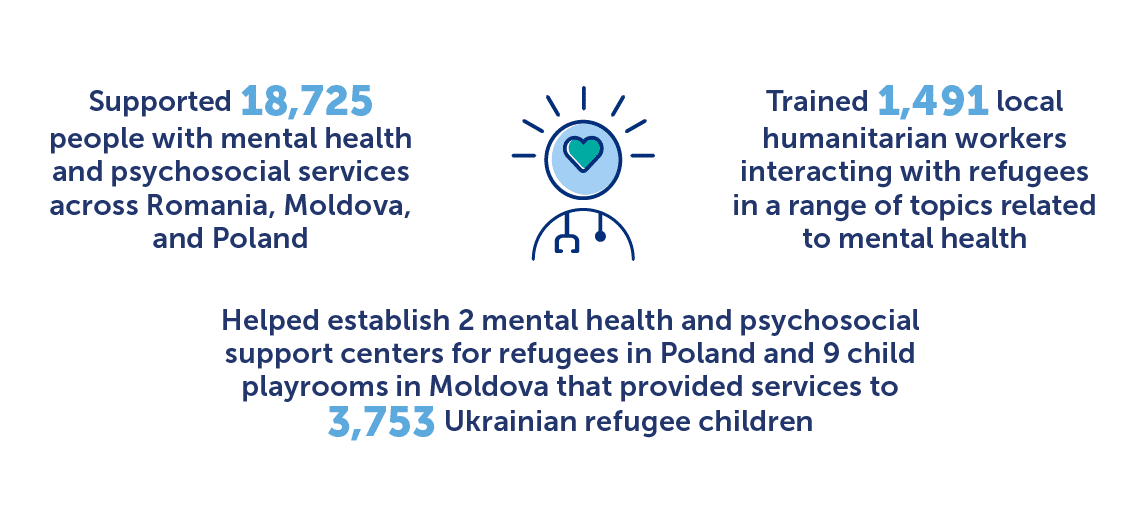
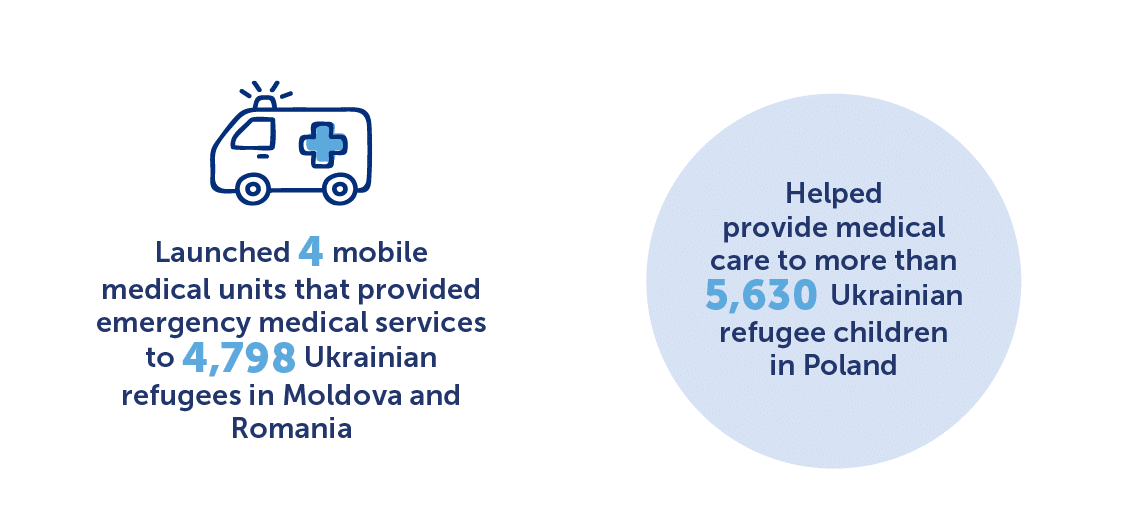
The Day Liana’s Life Changed
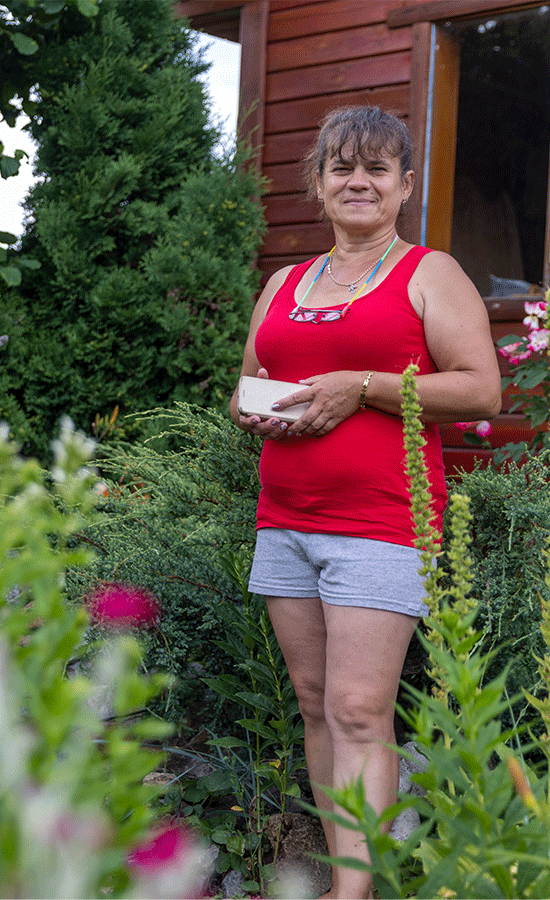
Liana remembers the day Ukrainian soldiers came to her village. It was the first sign that the fighting that had consumed her country was coming near her home. The soldiers urged the residents to get out and evacuate to safer areas, but some couldn’t leave because of their age, health, or other reasons. Liana’s husband decided he wanted to help and began evacuating neighbors himself, personally driving carloads of villagers out of danger into areas not under threat.
On March 17, 2022, while evacuating residents to safety, Liana’s husband was killed when a missile struck his car on the road.
It was a profound loss that changed the calculus of her life. Not long after, their home they had been building for 15 years was destroyed in the fighting, along with the business they ran together. In an instant, the only life she knew was over.
From the first moments of Russia’s invasion, Project HOPE’s team in Ukraine has worked tirelessly to restore access to health care and provide urgent relief for Ukrainians across the region. In Borodyanka, not far from Liana’s village, Project HOPE’s reconstruction projects helped restore care at Borodyanka Central Hospital, Borodyanka Municipal Pharmacy, Dmytrivka Urgent Care Unit, and a hospital for patients with psychological conditions.
The reconstructions, which continue today, are part of Project HOPE’s far-reaching, coordinated response to meet the health care needs of Ukrainians in a time of intense need.
Julia, a project coordinator for Project HOPE’s reconstruction projects, feels a close connection to the work. Borodyanka is her hometown.
“It’s terrible when war becomes routine,” she says. “We should not get used to it. I sincerely hope that 2023 will be a year of peace for Ukraine, for the Ukrainian people, and for all of humanity.”

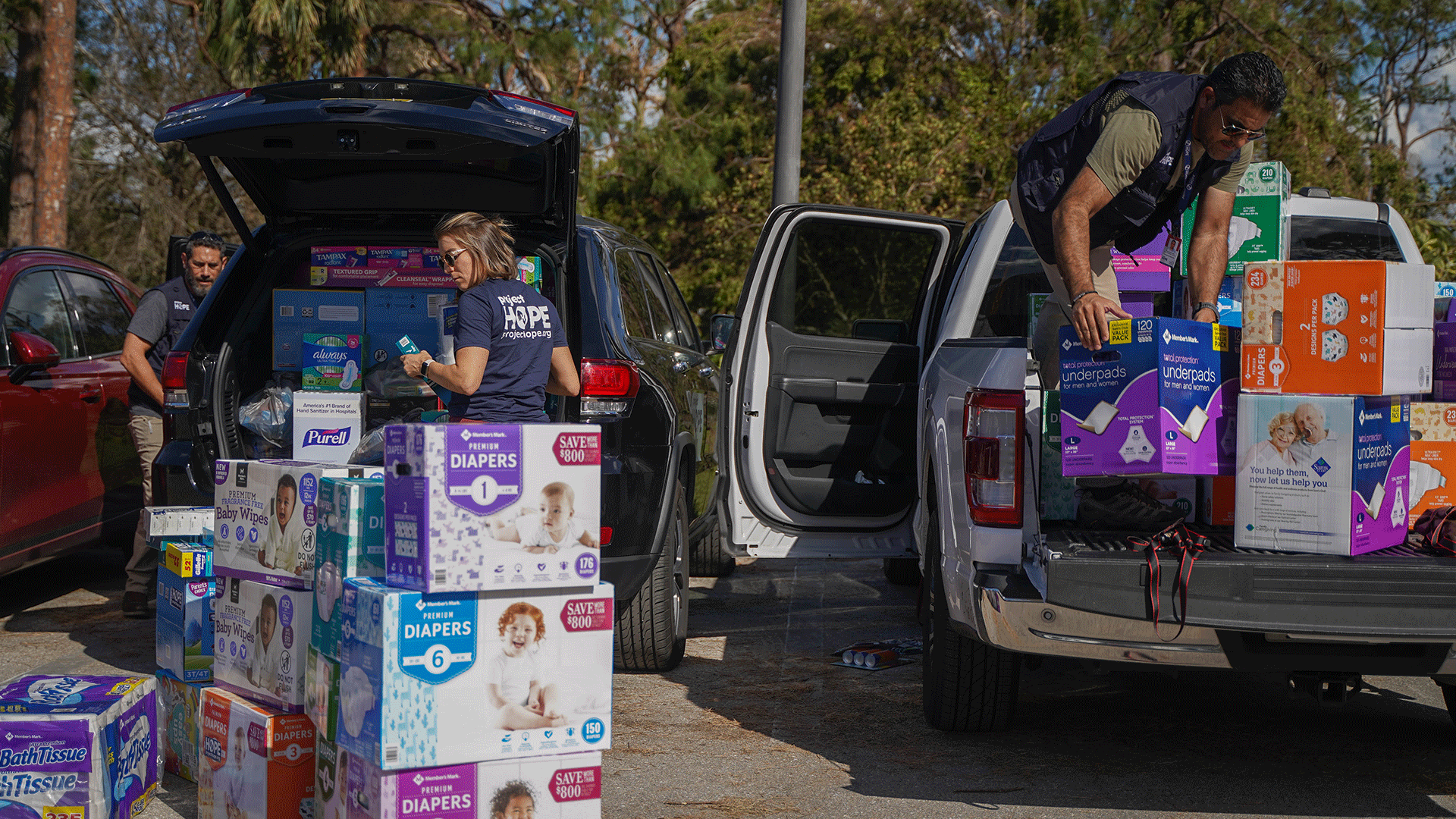
Responding to Major Hurricanes in the U.S.
The 2022 Atlantic hurricane season proved devastating for communities in the Caribbean and U.S. Gulf Coast. In September, Hurricane Fiona caused catastrophic flooding and widespread blackouts in Puerto Rico and the Dominican Republic; just 10 days later, Hurricane Ian became one of the strongest storms in history to make landfall in Florida.
In Puerto Rico, Project HOPE engaged with shelters and the surrounding areas, providing 11,310 hygiene kits to affected populations. The team procured 800 blood pressure monitors for local health facilities and 10 water filters for senior homes and clinics. The Emergency Response Team also mobilized local medical staff and mental health and psychosocial support for home visits within affected communities to provide care and case referrals to local clinics. Project HOPE also procured 1,724 FRIO bags for distribution, which allow individuals to keep their insulin cold when electricity is unavailable. After Hurricane Maria in 2017, Project HOPE installed a cold-chain system in Puerto Rico that remained functional in Fiona’s aftermath.
In the Dominican Republic, our Emergency Response Team distributed 1,180 hygiene kits and provided 43 medical facilities with replacement surgical tools and five community clinics with medical supplies. The team also procured 10,500 mosquito nets along with insect repellants for distribution to address the threat of vector-borne diseases resulting from the substantial rain and flooding. Project HOPE staff worked with local educators to ensure that proper use of mosquito nets was communicated to their recipients and to spread awareness about sanitation for the purpose of preventing mosquito breeding sites.
In Florida, The Project HOPE team supported 12 shelters, six free and charitable clinics, and 12 community centers with more than 350,000 units of hygiene supplies, cleaning products, and medical supplies that reached approximately 12,281 people. Our response team also established partnerships with three local organizations to provide service delivery, supplies for distribution, and mental health trainings that continued into 2023.

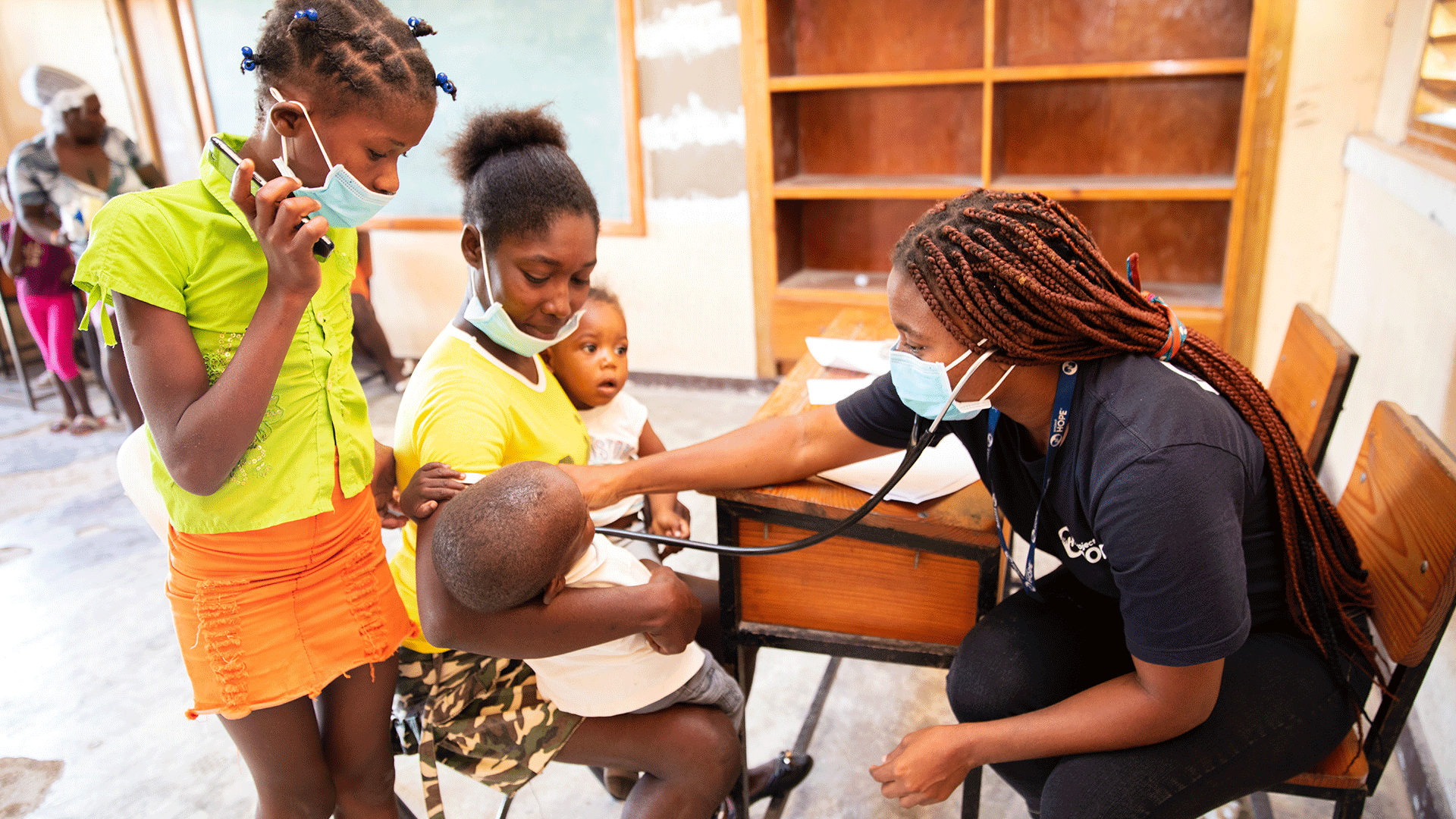
Addressing Long-Term Impacts in Haiti
The 7.2-magnitude earthquake that struck southern Haiti in August 2021 brought an immense amount of devastation and need. But the long-term impacts of a natural disaster can be harder to see: clinics that don’t reopen, roads that remain impassable, and illnesses brought on by a lack of clean water. These impacts were acutely felt in Haiti’s rural communities, where health care can be too expensive or too distant to access.
Project HOPE, with support from the U.S. Agency for International Development’s (USAID’s) Bureau for Humanitarian Assistance, invested in Haiti’s long-term recovery by connecting the island’s rural communities such as Boucan and Mouline to care through support such as mobile clinics, clean water filters, and donations of medical supplies to equip doctors and nurses on the ground.
“We are doing mobile clinics each day. That’s the reason we drive more than two hours — in order to reach people in the most hard-to-reach areas in southern Haiti. The more supplies we can provide, the more people we can help. We don’t want to stop.
I feel good about what I am doing because I love helping people, especially when they are in need. I want to help people who have no money to buy medication, people who don’t have access to hospitals. My suitcase is always packed for whenever I get called.”
–Sam, Project HOPE nurse supervisor, Haiti
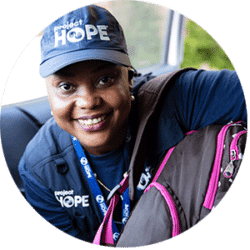

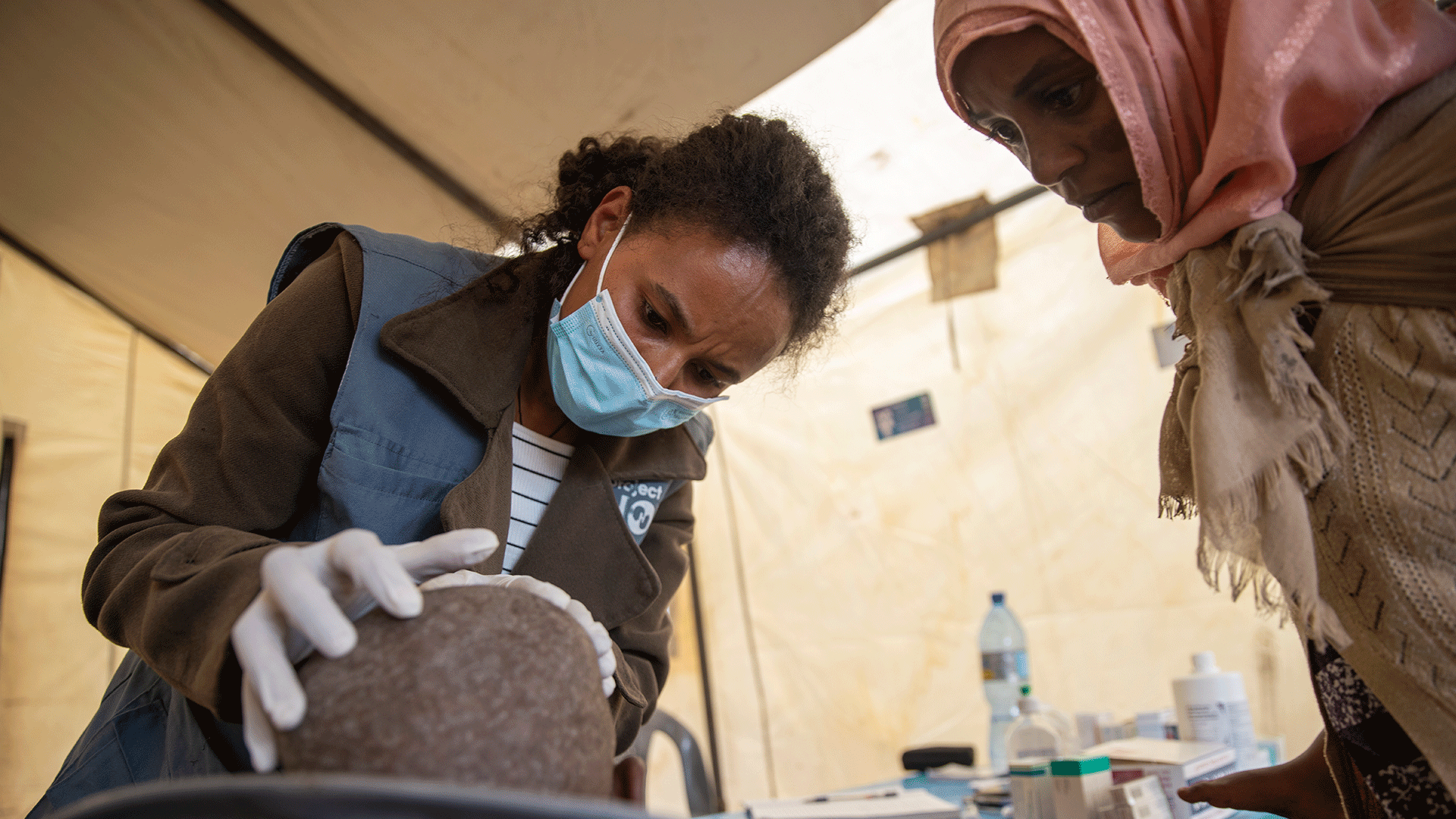
Strengthening Health Systems in Ethiopia
Multiple emergencies compounded in Ethiopia in 2022, including the worst drought in four decades and a widespread conflict that displaced more than 4 million people. The ripple effects of Russia’s invasion of Ukraine affected global food security, leading to the threat of widespread starvation in the Horn of Africa. And as the conflict taking place within Ethiopia continued, thousands of hospitals and health clinics across the nation were damaged, destroyed, or looted, erasing many people’s only access to health care.
In response to the humanitarian crisis, Project HOPE launched multiple mobile health and nutrition teams to provide health services to internally displaced people and communities in need of care. Our teams provided essential medicines, vaccines, medical supplies, and ready-to-use therapeutic foods to conflict-affected populations, with a focus on supporting women, children, and people living with or affected by HIV.
“This hospital is supposed to be serving 500,000 people, but it is serving over 1 million. Medicine and medical equipment are challenges and we want to prevent stockouts. Project HOPE donated medicines from IHP [International Health Partners], which were of great need. Medications were so expensive and getting them free here was a big help. We want to say thank you.”
–Dr. Hussein Aden, CEO, Dubti Hospital, Afar Region, Ethiopia
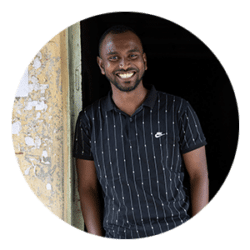
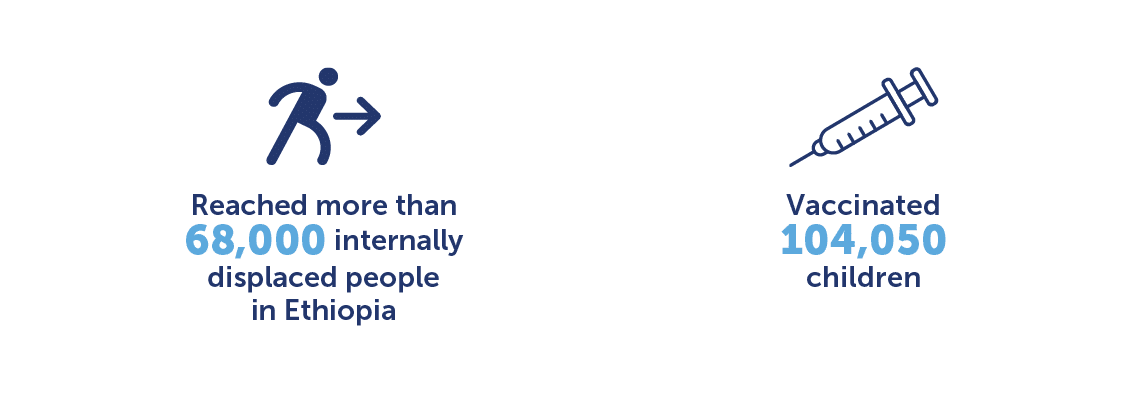
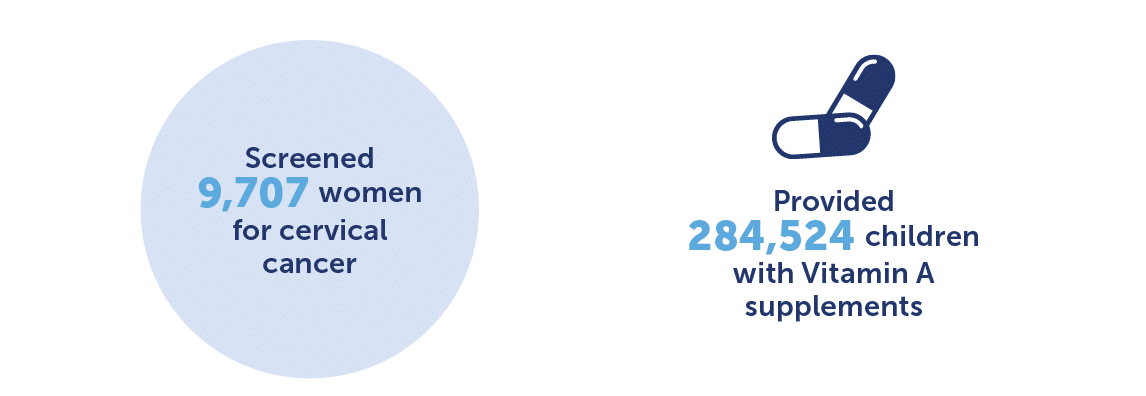
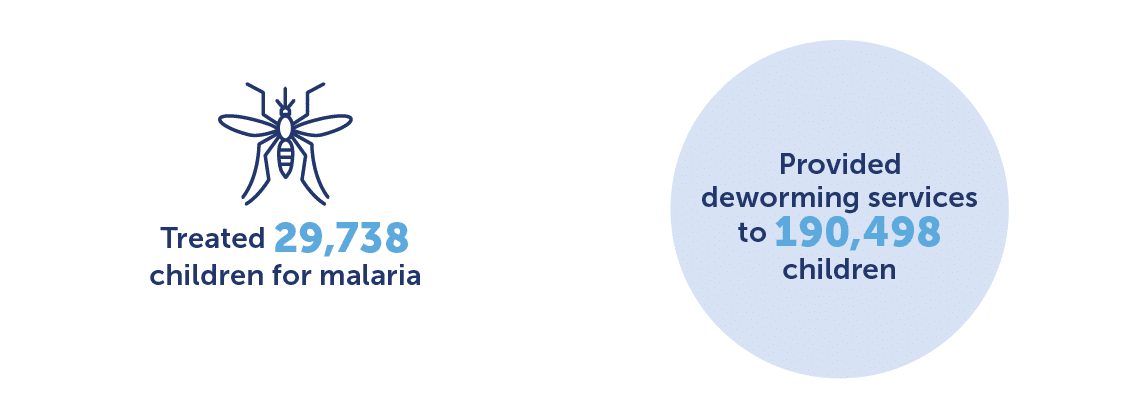
Project HOPE reached more than 68,200 internally displaced people and returnees in Ethiopia in 2022

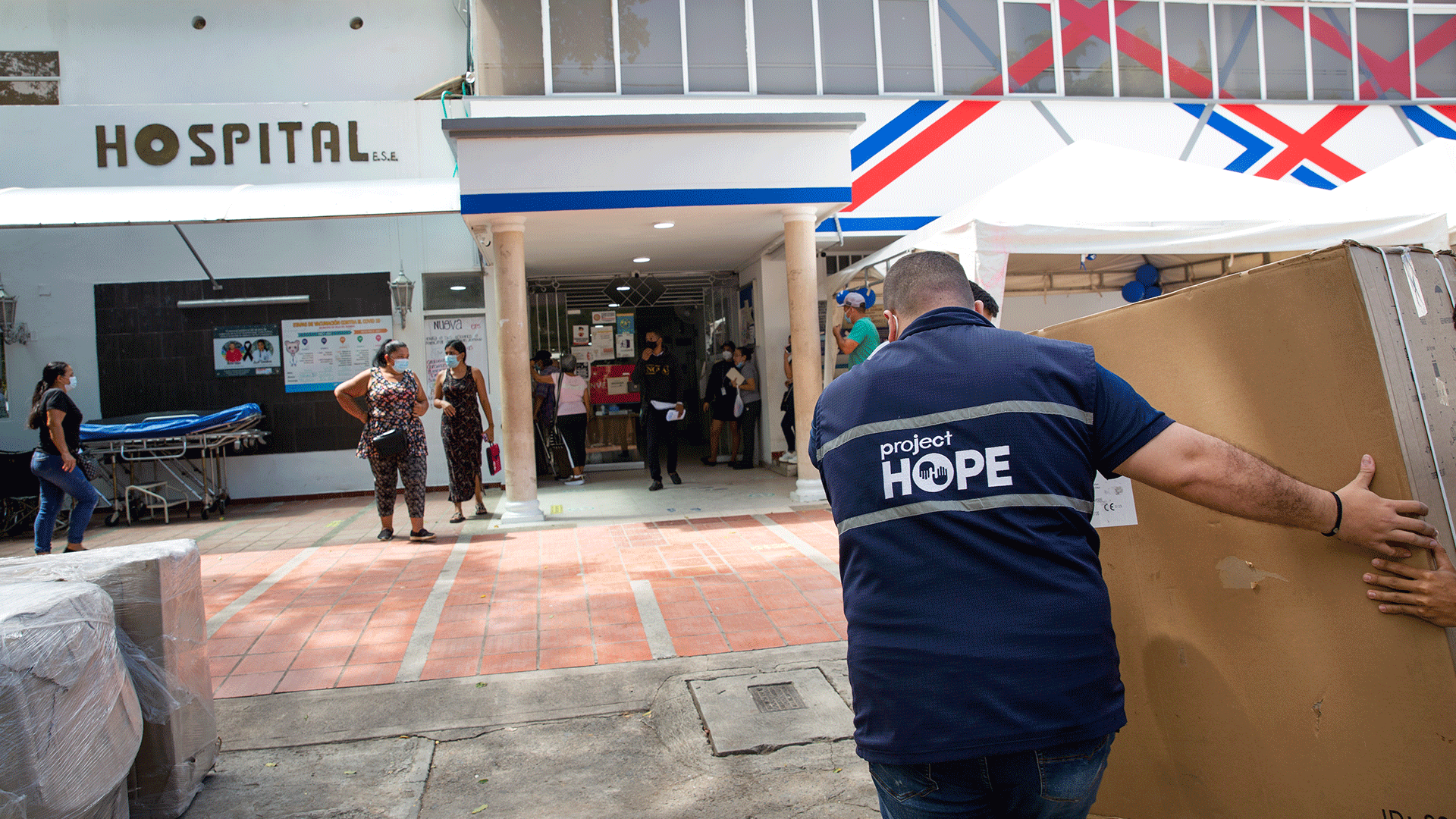
Connecting Venezuelans to Care in Colombia
Since 2015, the mass migration of Venezuelans has been one of the largest displacement crises in the world. Some Venezuelans are fleeing violence; others, economic collapse or insecurity. Among them are large numbers of pregnant women and mothers, many of whom have made the grueling trip alone or with their children.
More than 2.4 million migrants and refugees from Venezuela are now living in Colombia. The influx has strained Colombia’s local health systems, especially near the border in cities like Cúcuta. The need is especially acute inside maternity wards, where many pregnant Venezuelan women arrive having gone months with no prenatal care. Some are as young as 14 and carry extremely high-risk pregnancies.
Project HOPE is working inside hospitals and primary care clinics near the Colombia-Venezuela border to increase access to free, quality obstetric and gynecological care for women from Venezuela. This is done through coordinating surge rotations of general practitioners, nurses, and gynecologists, as well as providing pharmaceuticals, medical supplies, and equipment. We’re also partnering with a local women-run organization to bring Venezuelan women together in maternal care groups throughout the community and to ensure access to available health services through accompaniment and follow-up. Thanks to Project HOPE, more than 8,200 women received essential maternal care, health education, and support in 2022.
“We have been together with Project HOPE for many years now. This hospital doesn’t discriminate. We don’t charge anything. We’re taking away the myth that Venezuelans are taking our resources.”
–Dr. Mario Galvis, Erasmo Meoz University Hospital, Cúcuta, Colombia
Yolanda’s Journey
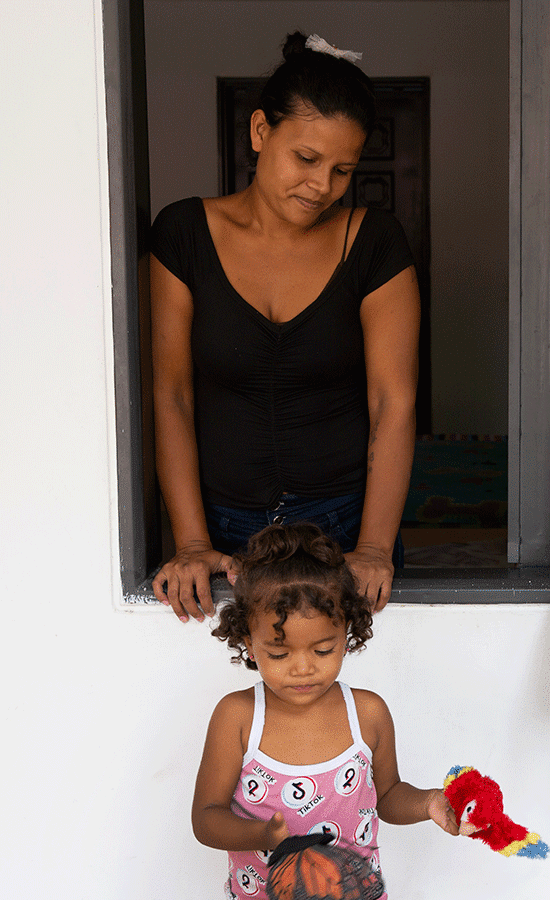
Yolanda knows where she’s going. But she doesn’t know how she’ll get there.
Just days before crossing into Colombia, the mom of three lost her own mother back home in Venezuela. Together with her 78-year-old father, who is blind, they buried her near their home. Then they gathered her three children and made a decision more than 7 million other Venezuelans had made before: to leave everything behind.
“We didn’t have enough food or clothes,” Yolanda says. “We were completely alone and didn’t have any help. Even if you have money, you can’t buy things because things are very expensive.”
When Yolanda’s family crossed the border into Colombia, one of their first stops was a clinic where Project HOPE provides urgent health care. For Yolanda, and so many others like her, this free health care has been absolutely essential because in Venezuela it was either too expensive, insufficient, or didn’t exist.
“I started with Project HOPE during the pandemic,” says Karen, a nurse at the clinic who provided care to Yolanda and her family. “The main job I do is to attend to patients who are coming in off the streets. Many people don’t trust us at first. But when I explain what I do, they feel comfortable. They come here looking for help.”
Yolanda’s plan is to live with her sister in Cali, Colombia, 600 miles away on the other side of the country. But until they are able to find the money for bus tickets to get there, she and her family hang in the in-between, holding on to their hope for a new life.
For her children and her father, Yolanda dreams of one thing: stability.
“When we arrive in Cali, we can get help from my sister,” she says. “I want to get a new job. I want my kids to get an education. But mainly I want someone who can take care of my father. He doesn’t have anyone who can care for him. I want a more stable situation.”

Strengthening Health Systems Worldwide
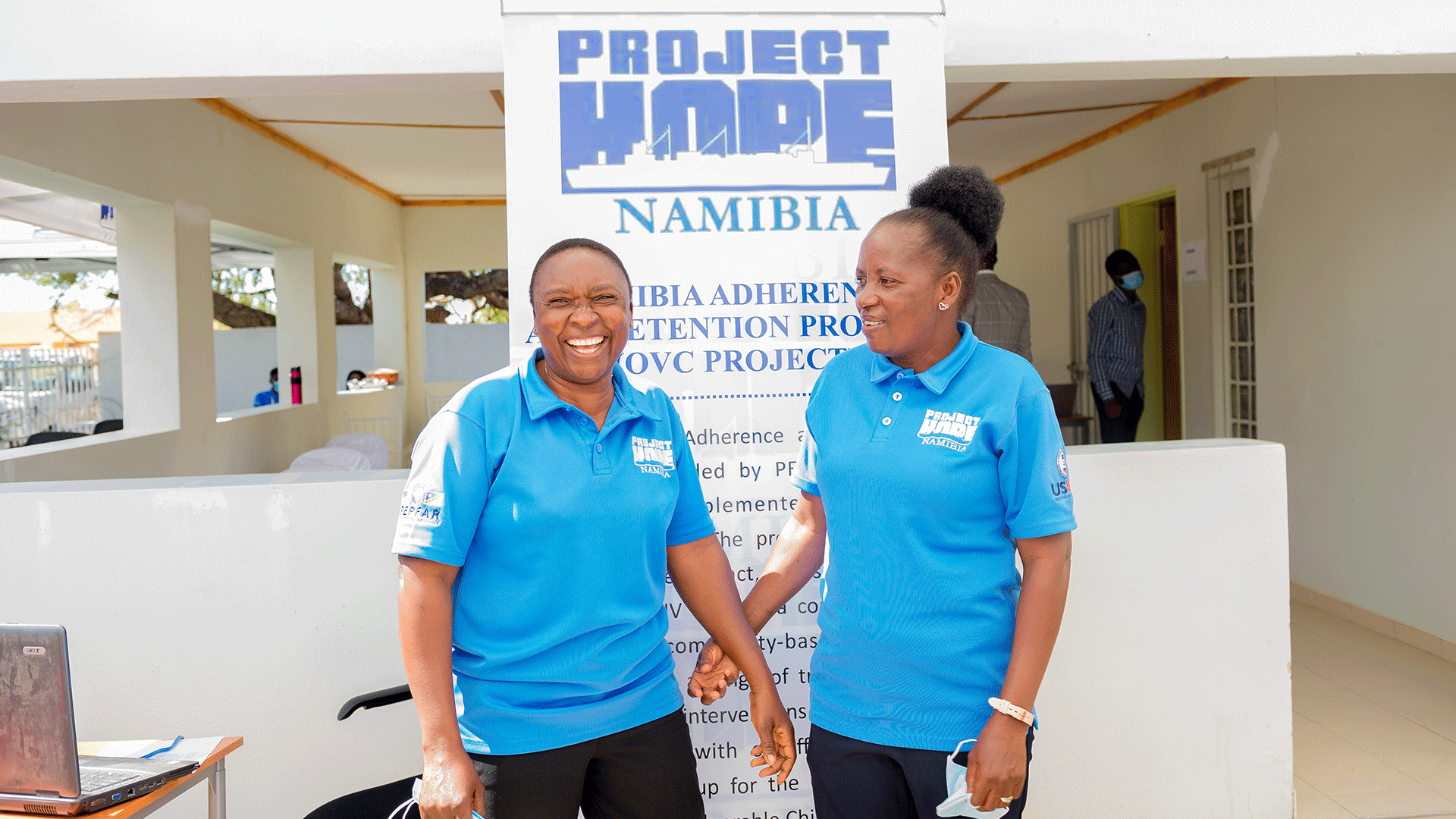
Indonesia
In Indonesia, Yayasan Project HOPE started implementation of the USAID PREVENT TB project to increase the uptake of tuberculosis-preventative treatment through a strategic health communication campaign for demand generation for identifying, screening, diagnosing, and supporting behavior change to increase uptake of tuberculosis-preventative services. Project HOPE also continued the Give2Asia-funded Saving Lives at Birth program, which helps health workers, midwives, obstetricians, pediatricians, and hospital workers deliver advanced emergency maternal obstetric and neonatal care to high-risk mothers and neonatal infants. In addition, Project HOPE implemented the Give2Asia-funded Improving Access to Mental Health and Psychosocial Support program that trained midwives to conduct screenings for mental health and psychological issues among pregnant women and mothers and provided psychological first-aid if needed.
After a 5.6-magnitude earthquake struck near the town of Cianjur in West Java, Yayasan Project HOPE immediately mobilized a response that included mobile medical care units, medical treatment, mental health and psychological support, family shelter kits, hygiene kits, and the construction of water, sanitation, and hygiene facilities in 10 camps for internally displaced people.
Namibia
Project HOPE Namibia implemented programs in all 14 regions of Namibia in 2022, addressing HIV/AIDS and pandemic preparedness and response and providing integrated support for adolescent girls, young women, orphans, and vulnerable children.
Through the President’s Emergency Plan for AIDS Relief (PEPFAR)/USAID-funded DREAMS (Determined, Resilient, Empowered, AIDS-free, Mentored and Safe) program, Project HOPE helped girls and young women reach their full potential — while reducing new HIV infections — through mentorships, youth-friendly sexual and reproductive health services, menstrual hygiene management materials, education support, financial literacy trainings, apprenticeships, small business support, job placements, and access to preexposure prophylaxis (PrEP) and HIV testing services. Through the PEPFAR/USAID-funded NARP (Namibia Adherence and Retention Project), Project HOPE Namibia reduced the impact of HIV through a community-based program that provided a range of treatment, care, and support interventions to orphans and vulnerable children affected by HIV.
Project HOPE Namibia has also begun implementing health systems strengthening activities across the African continent. With funding from the Mastercard Foundation and the Africa Centres for Disease Control and Prevention, Project HOPE Namibia is implementing the Saving Lives and Livelihoods initiative to increase COVID-19 vaccination coverage in North Africa.
Sierra Leone
In Sierra Leone, Project HOPE works with partners to expand community support for mothers and newborns, develop new neonatal nursing education programs, and build the skills of health care workers at all levels. As part of this work, Project HOPE’s team of volunteers helped the College of Medicine and Allied Health Sciences at the University of Sierra Leone establish a specialized neonatal nursing program, develop curricula, and train key faculty members. After the successful implementation of this work, the University of Sierra Leone and the Ministry of Health and Sanitation requested Project HOPE’s assistance in developing an advanced neonatal nursing master’s degree, which will admit its first students in 2023.
Dominican Republic
In the Dominican Republic, Project HOPE delivered critical equipment, trained health workers, and supported community-based health services to help save lives of pregnant women and newborns. With the support of the Elsa & Peter Soderberg Charitable Foundation, we strengthened maternal and child health services at the primary care level, as well as community-based health promotion for communities in La Vega Province and Santo Domingo. This included delivery of key equipment and the promotion of our “5 Star Mother” strategy, a training and mobile application developed for health workers and patient education on maternal and child health care. Through the fourth Saving the Newborn program, and in partnership with the National Health Service and supported by Dan Phelan, Larry Phelan, George Lindemann, Dick and Angie Clark, and Elsa and Peter Soderberg, we began expanding capacity of the neonatal intensive care unit, maternal intensive care unit, and laboratory at the Luis Morillo King Regional University Hospital; made critically needed enhancements to meet urgent needs; and expanded nationwide access to Pumani bubbleCPAP, a cost-effective and sustainable technology for ventilation support, in 20 hospitals.

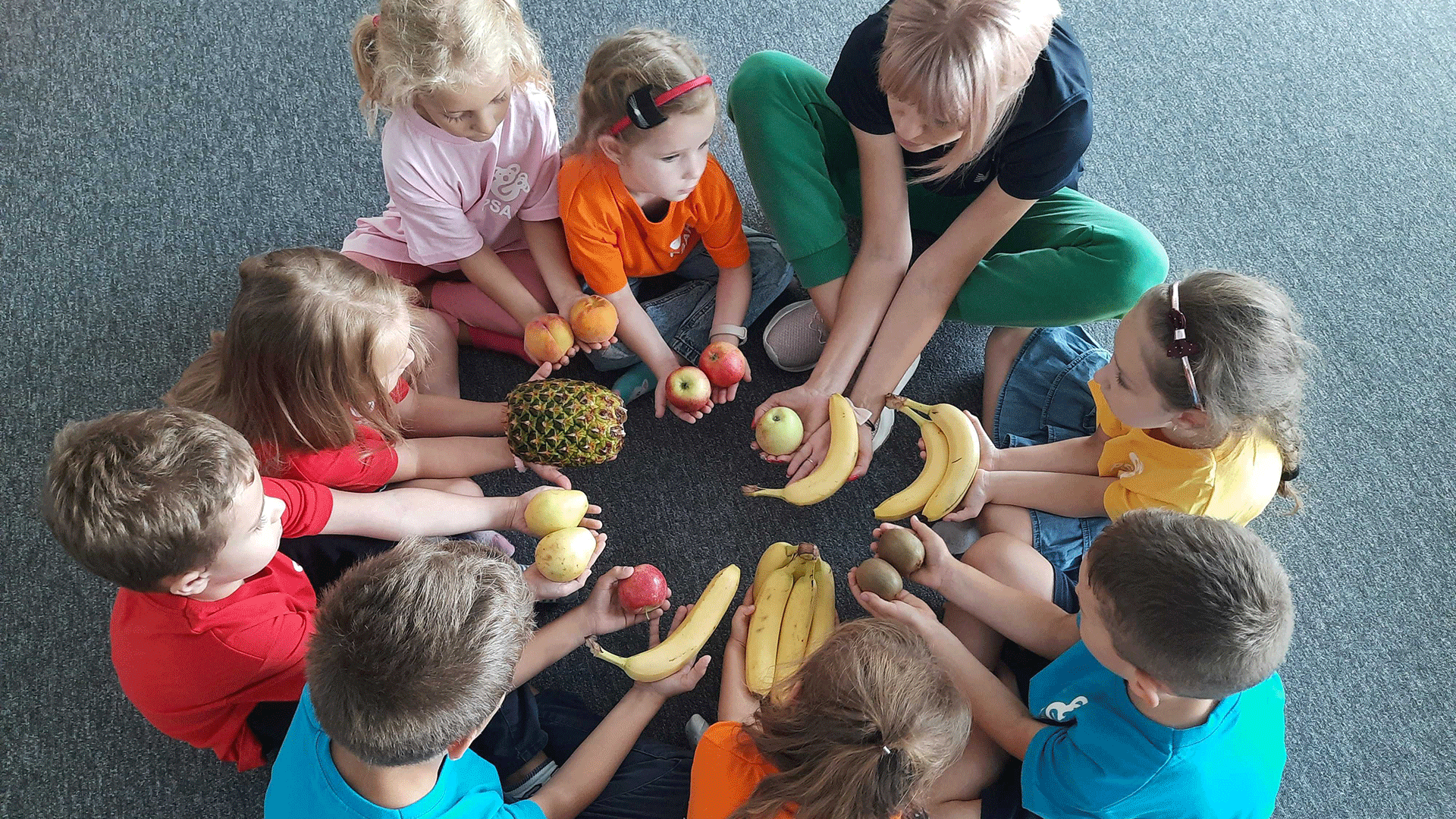
Expanding Access to Mental Health Care
With support from the Center for Disaster Philanthropy and Medtronic, Project HOPE continued expanding its mental health programming in 2022, including mental health and resiliency trainings for health care workers around the world. The trainings, which are now active on five continents, are based on a series developed by NYC Health + Hospitals and have reached more than 71,000 health workers worldwide. Project HOPE also provided mental health and psychosocial support services in the aftermath of emergencies, including psychosocial support centers for refugees in Poland, child playrooms for Ukrainian refugee children in Moldova, and safe spaces for children and women inside Ukraine.
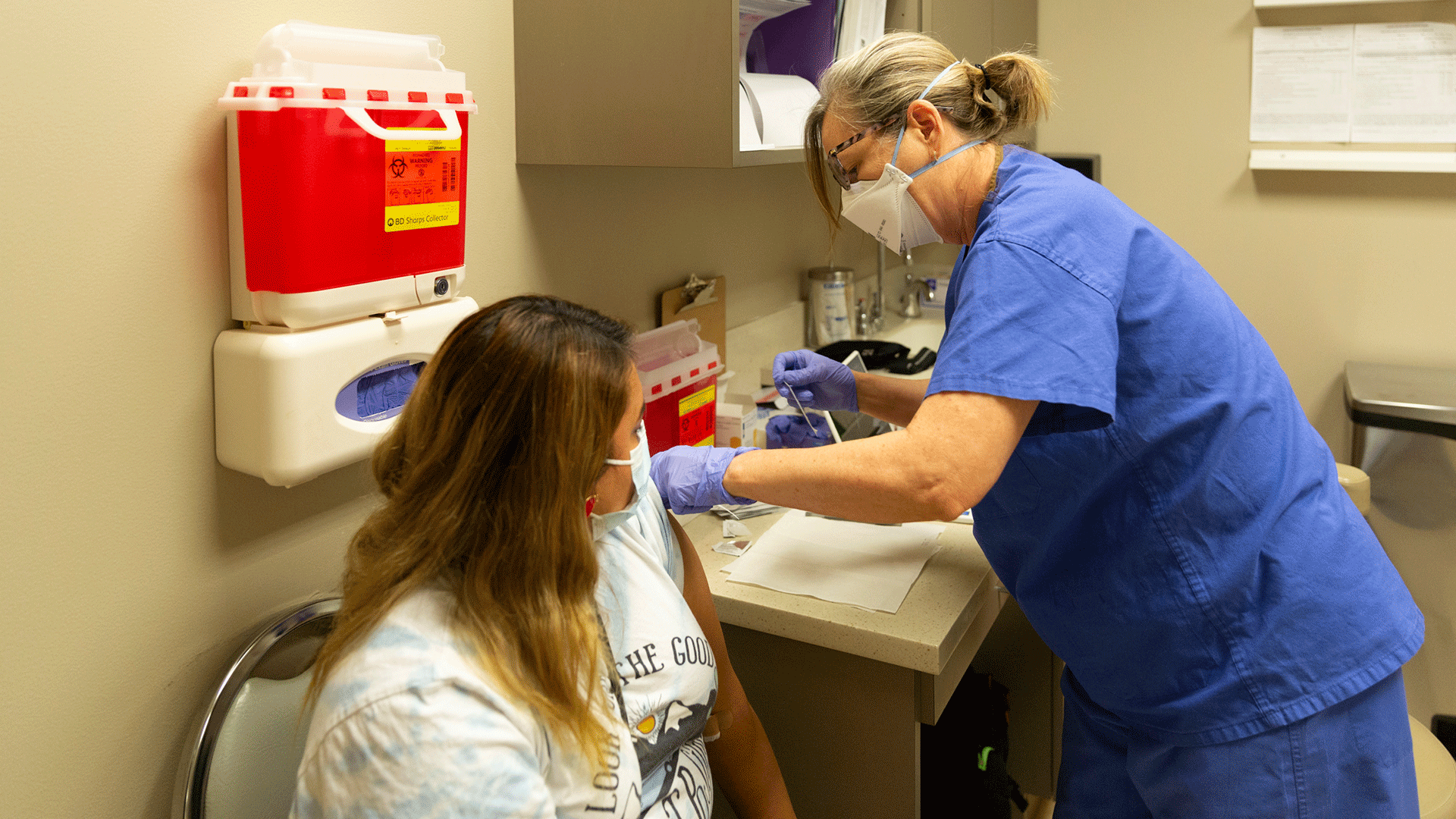
Supporting Free and Charitable Clinics in the U.S.
Thanks to funding from the Health Resources and Services Administration, Project HOPE supported 37 free and charitable clinics to improve COVID-19 vaccination rates in low-income and uninsured communities across Alabama, Florida, Georgia, Louisiana, and Texas. With Project HOPE’s support, the clinics were able to offer vaccination incentives and hire community health workers who served as a critical link to build trust, combat misinformation, and reach the most underserved populations. In addition, with the support of the Brave of Heart fund, Project HOPE delivered Mental Health & Resilience Train the Trainer curriculums to 218 health care workers in nine different free and charitable clinics through both live and online sessions.
“When we started, something like 29% of our patients were vaccinated,” says Dorothy Boozer, a community health worker at St. Michael’s Clinic in Anniston, Alabama. “Since working with Project HOPE, over 50% of our patients are fully vaccinated or have started the vaccination process. I don’t think you all know how many lives this grant has saved. Our patients are so sick. They would have died without it.”
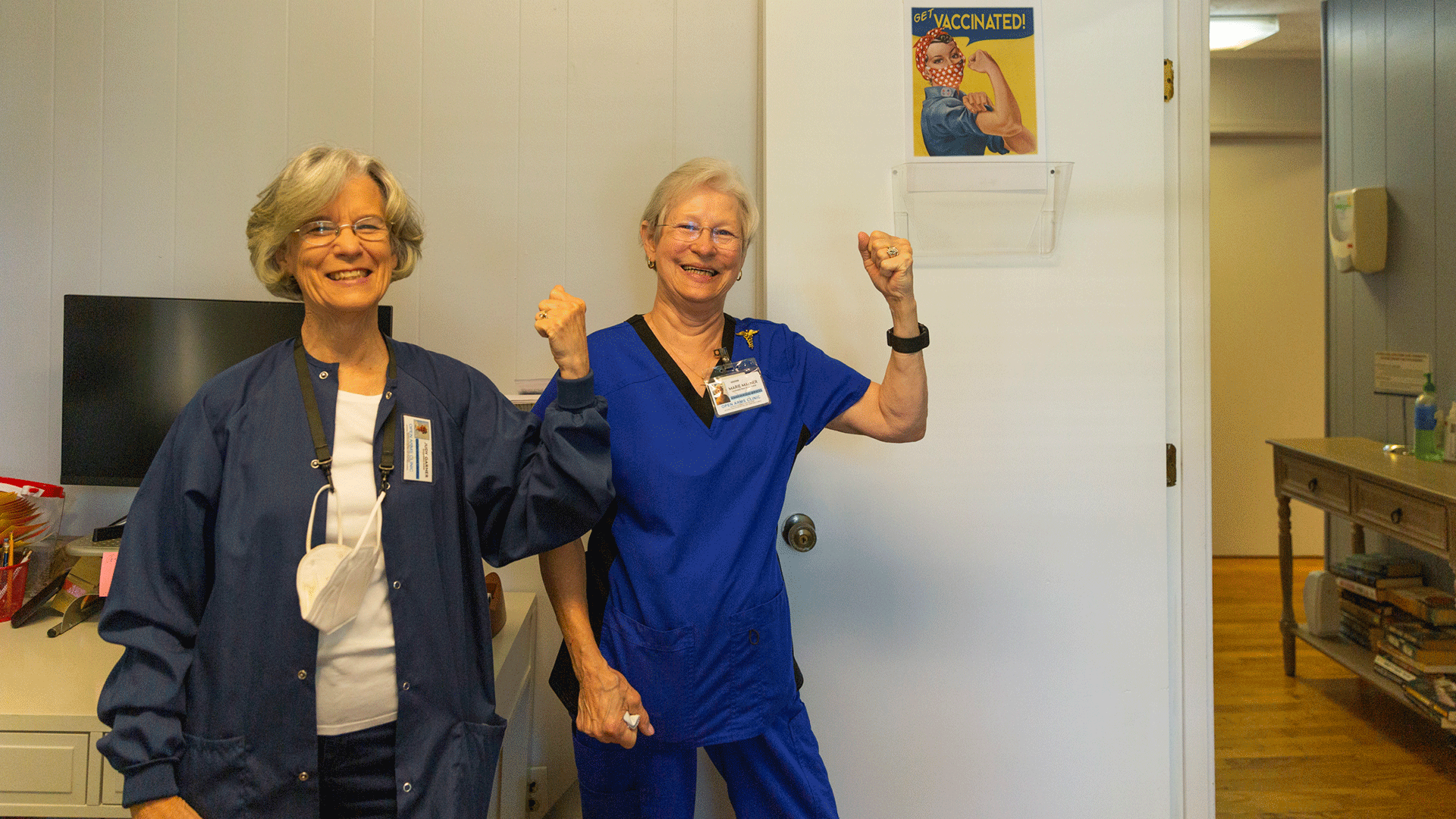
New Focus on Health Policy and Advocacy
In 2022, Project HOPE added a dedicated Policy and Advocacy team to advance better health and humanitarian policies, funding, and engagement. With deep health expertise and local understanding, now combined with policy awareness and political know-how, we aim to pursue policy change in four key areas: empowering local health workers, strengthening global health actions, supporting people in crisis, and increasing U.S. leadership and investment.
In its first months, Project HOPE’s Policy and Advocacy team placed opinion pieces in the national press on issues including Haiti, Ukraine, and the U.S. foreign assistance budget. We joined nongovernmental organization coalitions to forge policy and funding change on key topics including frontline health workers and mental health. And we commented on draft USAID and PEPFAR policies that shape U.S. and global funding on HIV/AIDS and other issues central to the Project HOPE mission.
Moving forward, Project HOPE will be positioned to engage prominently on international health and humanitarian assistance issues, both in the U.S. and globally. In concert with likeminded partners, we aim to establish further engagement with U.S. administrations, Congress, the United Nations, and the World Health Organization.
The Value of Community Health Workers
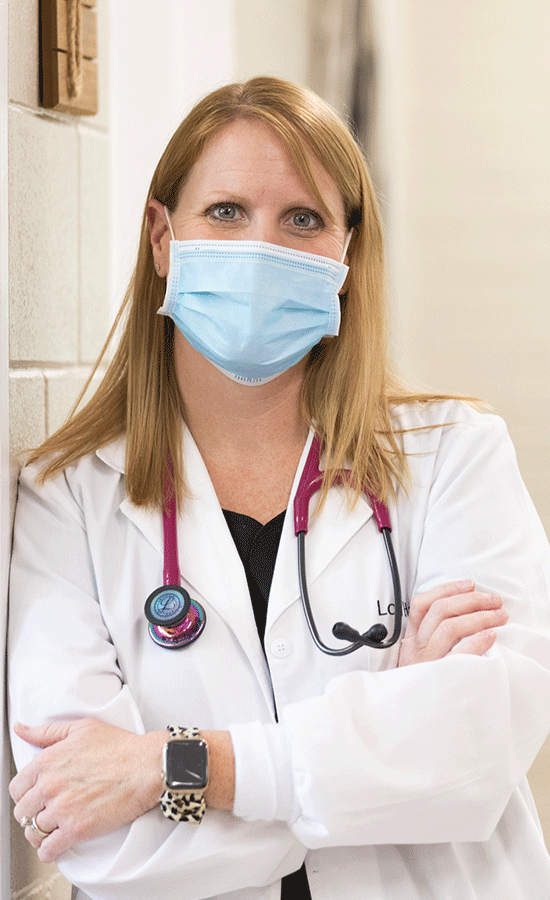
Lori remembers the darkest days of the pandemic in 2020. A nurse at an urgent care clinic in Alabama, she saw people at their most desperate, lining up in lawn chairs at 3:30 a.m. to get vaccinated as police patrolled the parking lot.
“People were so desperate,” she says. “Some had family who had died from it. You would tell people they had COVID, and it was like you told them they had cancer. They would cry.”
When Lori heard about an opportunity to work as a community health worker and reach uninsured patients through a local charitable clinic in her community, she didn’t hesitate.
“Public health is so important,” she says. “Especially with the population we see. They have such barriers. If we can get the COVID vaccine to them, we can help them and protect them.”
At St. Clair Community Health Clinic in Pell City, Alabama, Lori is the bridge to the clinic’s 900 patients, all of whom lack health insurance. She works to build trust, overcome misinformation, provide care, and refer patients to resources. The clinic is one of 37 free and charitable clinics Project HOPE has supported across five states, thanks to funding from the Health Resources and Services Administration.
Because of Project HOPE, charitable clinics across five high-risk states hired 159 community health workers, vaccinated more than 21,000 patients, and provided health and educational resources to more than 356,000 people.
“If people don’t have insurance, they feel like they’re not worthy,” says St. Clair’s director, Brooke Lowery. “They need to know you’re here for them and listening. Through Project HOPE, we were able to do marketing, to go out into the community and talk about COVID and vaccinations. That wouldn’t have been possible [otherwise]. We’re so thankful for Project HOPE.”

Health Affairs
Health Affairs, the peer-reviewed journal published monthly by Project HOPE, published two groundbreaking issues in 2022: “Racism & Health” in February and “Disability & Health” in October. These projects included major events attracting thousands of attendees, with Secretary Xavier Becerra of the Department of Health and Human Services offering a keynote for the event on racism. The journal also continued to feature timely topics in health policy, such as COVID-19, health care costs, and more.
To increase audience engagement and knowledge, Health Affairs continued its implementation of the goals outlined in the strategic plan adopted in 2019. These efforts included the continued expansion of its events and podcast program. In 2022, Health Affairs convened a record 50 events and added a new podcast, “Health Affairs Pathways.” Several funded series were added to Health Affairs Forefront on Medicare and Medicaid integration and other topics, reflecting its role at the leading edge of health and health policy.
Health Affairs Equity Program
In 2022, Health Affairs’ Equity Project graduated its first group of Health Equity Fellowship for Trainees (HEFT) fellows, with the first peer-reviewed study from one of those graduates to be published in 2023. Our equity initiative also began releasing a regular e-newsletter and was closely involved with the development of the two journal theme issues, as well as the companion videos. During 2022, Health Affairs continued to publish and elevate voices published in Health Affairs from several historically marginalized communities.
Harriet Washington Interview
To bolster the impact of the February “Racism & Health” theme issue, Health Affairs produced a companion video. Dr. Harriet Washington, author of the acclaimed 2006 book, “Medical Apartheid: The Dark History of Medical Experimentation on Black Americans from Colonial Times to the Present,” discussed the history of racism in medicine and research in an interview with Dr. Vabren Watts, Health Affairs’ director of health equity, and Dr. Aletha Maybank, chief health equity officer and senior vice president of the American Medical Association. The video won a prestigious Telly Award.
Other 2022 Health Affairs Accomplishments
With COVID-19 a lessening but still-present public health threat, Health Affairs’ multimedia content provided critically important and time-sensitive evidence for policy makers as well as the public. This was evidenced by the journal achieving its highest Impact Factor ever in 2022, at 9.048—a 44% increase from its 2021 Impact Factor. The journal also ranked number one in the “Health Policy and Services” category in the Clarivate Journal Citation Report.
Two important new products were launched in 2022. Health Affairs Scholar, which published its first issue in mid-2023, provides an additional high-level, peer-reviewed forum for the growing volume of cutting-edge health services research. In 2022, this new open-source journal’s editorial team and advisory board were selected, as well as its publication partnership with Oxford University Press. On the sales and marketing side, health policy mavens now have the chance to become Health Affairs Insiders, a membership opportunity allowing subscribers to receive exclusive access to content beyond the flagship journal and website.
Health Affairs podcasts continued to reach wider audiences in 2022, achieving approximately 10,000 monthly downloads overall. “A Health Podyssey” and “Health Affairs This Week” continued to establish themselves as must-listens for health policy followers.
Health Affairs content, particularly from the journal, continued to be widely cited by the news media, generating 2,172 media citations in 2022. A study published in the October “Disability & Health” issue, finding that many physicians did not want disabled people as their patients, was widely covered, including in a major story published in the New York Times.

Financial Summary
